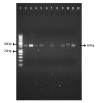Genotyping and phylogenetic analysis of Giardia duodenalis isolates from Turkish children
- PMID: 25689970
- PMCID: PMC4335576
- DOI: 10.12659/MSM.892318
Genotyping and phylogenetic analysis of Giardia duodenalis isolates from Turkish children
Abstract
Background: Giardiasis is caused by the intestinal protozoan parasite Giardia duodenalis (synonyms: G. lamblia, G. intestinalis), which is one of the most frequent parasites that infect Turkish children. However, molecular characterization of G. duodenalis in Turkey is relatively scarce. The present work aimed at genotyping G. duodenalis isolates from Turkey using molecular techniques.
Material and methods: In the present study, 145 fecal samples from children were collected to search for the presence of Giardia by microscopy and PCR screening. PCR generated a 384 bp fragment for β-giardin. The PCR products were sequenced and the sequences were subjected to phylogenetic analysis by using PHYLIP.
Results: Based on the phylogenetic analysis of the sequences, assemblage A, B, and mixed subtypes were determined. Of 22 isolates, 11 were identified as assemblage A (50%), 7 were assemblage B (31.8%), and 4 were assemblage AB (18.2%). Association between G. duodenalis assemblages and the epidemiological data was analyzed. No correlation was found between symptoms and infection with specific assemblages (P>0.05), but we found statistically significant association between age and the assemblage AB (P=0.001).
Conclusions: The association between G. duodenalis and the epidemiologic data were analyzed. Since assemblage A is the more prevalent subgroup compared with assemblage B, this subgroup might be responsible for common Giardia infections in Turkey. This is the first study that included a detailed phylogenetic analysis of Giardia strains from Turkey.
Figures
References
-
- Savioli L, Smith H, Thompson A. Giardia and Cryptosporidium join the ‘Neglected Diseases Initiative’. Trends Parasitol. 2006;22:203–8. - PubMed
-
- Lima AA, Moore SR, Barboza MS, et al. Persistent diarrhea signals a critical period of increased diarrhea burdens and nutritional shortfalls: a prospective cohort study among children in northestern Brazil. J Infect Dis. 2000;181:1643–51. - PubMed
-
- Tamer SG, Erdogan S, Willke A. The frequency of the presence of intestinal parasites in students of Arslanbey Primary School. Turkish Society for Parasitology. 2008;32:130–33. - PubMed
Publication types
MeSH terms
Substances
LinkOut - more resources
Full Text Sources
Medical



